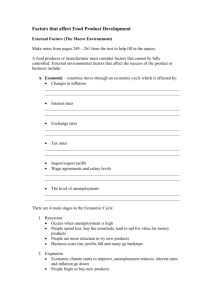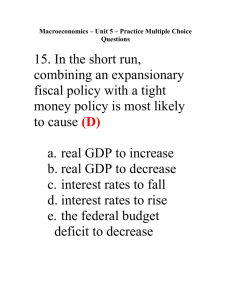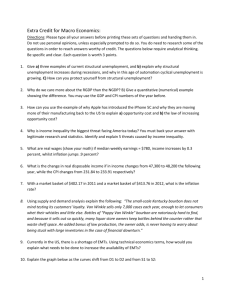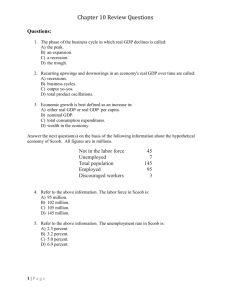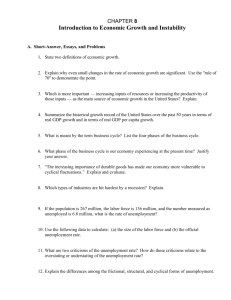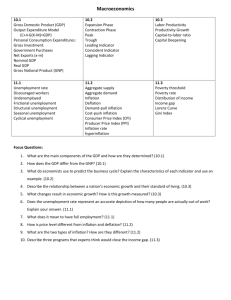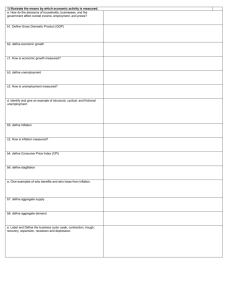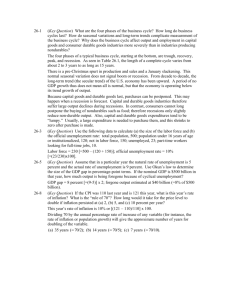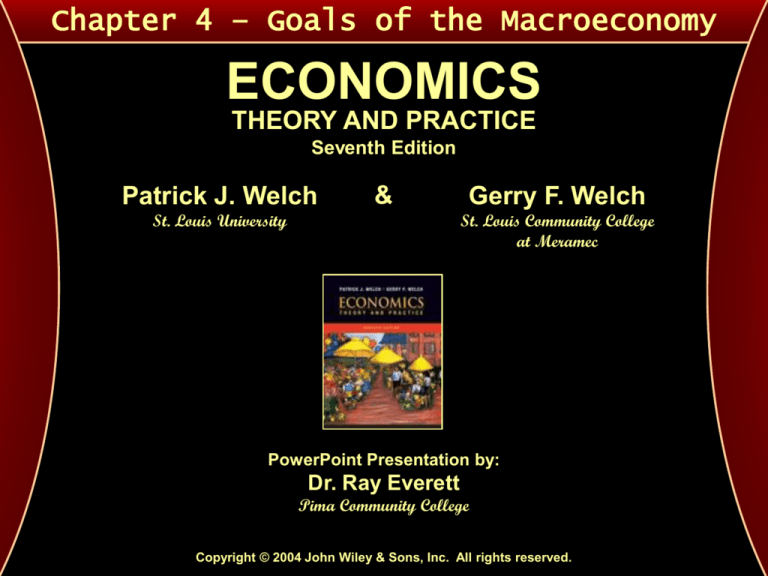
Chapter 4 – Goals of the Macroeconomy
ECONOMICS
THEORY AND PRACTICE
Seventh Edition
Patrick J. Welch
&
St. Louis University
Gerry F. Welch
St. Louis Community College
at Meramec
PowerPoint Presentation by:
Dr. Ray Everett
Pima Community College
Copyright © 2004 John Wiley & Sons, Inc. All rights reserved.
Goals & Problems of the Macroeconomy
Contents
Macroeconomy Overview
Unemployment & Full Employment
Employment & Unemployment Stats.
Inflation & Stable Prices
Deflation & Disinflation
Production Overview
Possible Policy Problem
Goals & Problems of the Macroeconomy
Chapter Objectives
• To introduce the three fundamental areas on which macroeconomics
focuses: employment, prices, and production.
• To define unemployment, explain its consequences, and identify
different types of unemployment.
• To introduce common measures and statistics on employment and
unemployment and discuss the interpretation of these data.
• To discuss full employment.
• To define inflation, explain its consequences, and identify its causes.
• To introduce measures and statistics on inflation.
• To distinguish between deflation and disinflation.
• To define full production and economic growth.
• To identify factors contributing to economic growth and to introduce
some costs associated with growth.
• To introduce GDP, the primary measure or production.
• To define productivity and discuss changes in U.S. productivity over
the years.
Macroeconomy Overview
• Macroeconomy
Study of the operation of the economy as a whole.
Focuses on:
• The roles of household, business, and government sectors.
Includes:
•
•
•
•
•
•
Aggregate employment & production
Unemployment
Inflation
Economic growth
Money
Government stabilization policies
4-1
Unemployment & Full Employment
• Employment Act of 1946
Legislation giving the federal government the right and
responsibility to provide an environment for the
achievement of full employment, full production, and
stable prices.
• Unemployment
Resources available for production are not being used.
• Consequences of Unemployment
Economic loss for society
• Unemployment intensifies the scarcity problem, and the
loss to society is the goods and services that might have
been enjoyed.
Individual hardships
• Unemployment intensifies an individual’s struggle with
scarcity because spending habits and lifestyles are altered
due to the lack of employment.
4-2a
Unemployment & Full Employment
• Types of Unemployment
Frictional Unemployment
• Occurs when people are voluntarily out of work for a short
period of time while searching for a job.
Cyclical Unemployment
• Involuntary unemployment that results from a downswing in
a business cycle, or recession.
– Continues until the economy breaks out of the recession.
Structural Unemployment
• Involuntary unemployment that results when a worker’s job
is no longer part of the production structure of the economy.
– Continues indefinitely; no prospect for rehire.
• Full Employment
Occurs when only those voluntarily out of work are
unemployed, or the unemployment rate includes only
frictional unemployment.
4-2b
Employment & Unemployment Statistics
• Measures & Statistics Overview
Labor Force
• All persons 16 years of age and older who are working or
actively seeking work.
Participation Rate
• Percentage of some specified group that is in the labor
force.
Unemployment Rate
• Percentage of the labor force that is unemployed and
actively seeking work.
4-3a
Employment & Unemployment Statistics
• Measures & Statistics Overview (cont.)
4-3b
Employment & Unemployment Statistics
• Measures & Statistics Overview (cont.)
4-3c
Employment & Unemployment Statistics
• Measures & Statistics Overview (cont.)
4-3d
Employment & Unemployment Statistics
• Calculating Unemployment Statistics
Calculated:
• By the U.S. Department of Labor, Bureau of Labor Statistics
(BLS).
• Monthly and annually.
• Using results from the Current Population Survey.
– Survey issued to a scientifically developed sample of
households across the U.S. each month.
Considered employed if:
• Did any work during the survey week as a paid employee.
– Includes self-employed individuals.
• Worked without pay for 15 or more hours in a familyoperated business.
• Was temporarily away from a job or business due to illness,
weather, vacation, labor-management disputes, or personal
reasons.
4-3e
Employment & Unemployment Statistics
• Interpreting Unemployment Statistics
Factors to consider:
• Discouraged Workers
– Persons who drop out of the labor force because they
have been unsuccessful for a long period of time in
finding a job.
• Regional differences in unemployment
• Types of jobs held by the unemployed
• Underemployment
– Resources are not used to their fullest productive
capability.
4-3f
Employment & Unemployment Statistics
• Goal of Full Employment
Does not mean 100% of the labor force is working.
Rate associated with full employment has changed over
the years due to factors such as:
• Changes in the composition of the work force
– Women used to have higher unemployment rates than
men, but those rates are not comparable to male workers.
• Duration and quantity of government assistance programs
– May influence people’s decisions to remain out of work.
• Growth in temporary and part-time work
– Jobs are plentiful and people are counted as employed.
• Natural Rate of Unemployment
Unemployment rate that includes the frictionally and
structurally unemployed.
4-3g
Inflation & Stable Prices
• Inflation
An increase in the general level of prices.
• Hyperinflation
Extremely rapid increases in the general level of prices.
• Consequences of Inflation
Intensifies scarcity when income does not rise as quickly
as prices.
Penalizes some groups, such as savers receiving low
interest rates.
Changes the value of assets.
Politically and socially destabilizing.
4-4a
Inflation & Stable Prices
• Nominal Income (Money)
Income measures in terms of current currencies.
• Real Income
Income measured in terms of the goods and services
that can be purchased with a particular amount of money
income.
• Cost of Living Adjustments (COLAs)
Arrangement whereby an individual’s wages
automatically increase with inflation.
4-4b
Inflation & Stable Prices
• Cost of Living Adjustments (cont.)
FIGURE 4-1
The Purchasing Power of Income
4-4c
Inflation & Stable Prices
• Inflation and the Interest Rate
Interest Rate
• The price of money.
– Determines the return to savers and lenders of money,
and the cost to borrowers.
The Real Rate of Interest
• Nominal, or stated, rate of interest minus the inflation rate.
– Nominal interest rate adjusted for inflation.
• Wealth and the Interest Rate
Wealth
• Measure of the value of tangible assets.
– Includes such items as real estate and corporate
securities.
4-4d
Inflation & Stable Prices
• Social and Political Consequences of Inflation
4-4e
Inflation & Stable Prices
• Causes of Inflationary Pressure
Demand-Pull Inflation
• Pressure on prices from the buyers’ side of the market.
• Tends to occur when spending is greater than the
productive capability of the economy, and when an
economy is close to or at full employment.
Cost-Push Inflation
• Pressure on prices from the sellers’ side of the market,
particularly from increases in the costs of production.
• Occurs due to increased costs of labor, raw materials, fuels,
machinery, borrowing, and even attempts to increase profit.
Role of Expectations
• Our expectations about inflation can cause inflation to
occur.
4-4f
Inflation & Stable Prices
• Measures of Inflation
Price Index
• Measures changes in the price of an item or a group of
items using a percentage scale.
– Consumer price index
– Producer price index
– GDP price index
• Constructing a Price Index
Base Year
• Year against which prices in other years are compared in a
price index.
4-4g
Inflation & Stable Prices
• Constructing a Price Index (cont.)
4-4h
Inflation & Stable Prices
• Consumer Price Index
Measures changes in the prices of goods and services
that consumers typically purchase.
FIGURE 4-6
Consumer Price Index: All Items and Various Categories
for Selected Years (1982–1984 = 100.0)
4-4i
Inflation & Stable Prices
• Consumer Price Index (cont.)
FIGURE 4-2
Annual Percentage Changes in the Overall CPI
4-4j
Inflation & Stable Prices
• Other Price Indexes
Producer Price Index (PPI)
• Measures changes in the prices of goods that businesses
buy, either for further processing or for sale to a consumer.
GDP Price Index
• Price index used when calculating price changes for the
entire economy.
4-4k
Deflation & Disinflation
• Deflation and Disinflation
Deflation
• Sustained decrease in the general level of prices.
Disinflation
• Slowing of the inflation rate.
4-5
Production Overview
• Production
Creation of goods and services.
• Full Production and Economic Growth
Full Production
• Occurs when an economy is producing at its maximum
capacity, or when it is experiencing full employment.
Economic Growth
• Increase in an economy’s full production output level over
time.
4-6a
Production Overview
• Full Production and Economic Growth (cont.)
FIGURE 4-3
Economic Growth
4-6b
Production Overview
• Achieving Economic Growth
Technology
• Increase in knowledge about production and its processes.
Human Capital Investments
• Investments, such as formal education, that increases the
productivity of people.
FIGURE 4-4
U.S. Economic Growth: Real Output per Capita
4-6c
Production Overview
• Costs of Economic Growth
Increased amounts of waste
Depletion of resources
Reasons to purchase new or better items
• Dissatisfaction of possessions must be instilled in a person
to encourage them to continually want replacement items.
• Measures of Production
Gross Domestic Product (GDP)
• Dollar figure that measures the value of all finished goods
and services produced in an economy in one year.
Nominal GDP (Money GDP)
• Measures the value of production in terms of prices at the
time of production.
Real GDP (Constant GDP)
• Money GDP adjusted to eliminate inflation.
4-6d
Production Overview
• Measures of Production (cont.)
4-6e
Production Overview
• Assessing U.S. Production
TABLE 4-8
Money GDP, Real GDP, and the GDP Price Index for Selected Years
4-6f
Production Overview
• Underground Economy
Productive activities that are not reported for tax
purposes and are not included in GDP.
• Nonmarket productive activities
– Volunteer work, maintaining your car, etc.
• Unreported work
– Mowing lawns, full-time housecleaning, tips, etc.
• Swapped services
– Dental work in exchange for legal advice.
4-6g
Production Overview
• Productivity
Concept of assessing the amount of output produced by
an economy’s resources.
• Often measures specifically by output per worker.
TABLE 4-9
Growth in Labor Productivity: Business Sector, 1970–2001
4-6g
Possible Policy Problem
• Dilemma Facing Policymakers
Full production and full employment with inflation, or
Stable prices and less than full production with
unemployment?
4-7
Chapter 4 – Goals of the Macroeconomy
This is the end of Chapter 4.
To return to the contents menu of this
chapter, click on the menu graphic to the
right of this text.
To begin Chapter 5, click on the next
chapter icon to the right of this text.
Menu
Next
Chapter
ECONOMICS
THEORY AND PRACTICE
Seventh Edition
Copyright © 2004 John Wiley & Sons, Inc. All rights reserved. Reproduction or translation of this work
beyond that permitted in Section 117 of the 1976 United States Copyright Act without the expressed
written permission of the copyright owner is unlawful. Request for further information should be
addressed to the Permissions Department, John Wiley & Sons, Inc. The purchaser may make back-up
copies for his/her own use only and not for distribution or resale. The Publisher assumes no
responsibility for errors, omissions, or damages, caused by the use of these programs or from the use
of the information contained herein.

